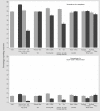Physical Activity Surveillance Through Smartphone Apps and Wearable Trackers: Examining the UK Potential for Nationally Representative Sampling
- PMID: 30694198
- PMCID: PMC6371078
- DOI: 10.2196/11898
Physical Activity Surveillance Through Smartphone Apps and Wearable Trackers: Examining the UK Potential for Nationally Representative Sampling
Abstract
Background: Smartphones and wearable activity trackers present opportunities for large-scale physical activity (PA) surveillance that overcome some limitations of questionnaires or researcher-administered devices. However, it remains unknown whether current users of such technologies are representative of the UK population.
Objective: The objective of this study was to investigate potential sociodemographic biases in individuals using, or with the potential to use, smartphone apps or wearable activity trackers for PA surveillance in the United Kingdom.
Methods: We used data of adults (aged ≥16 years) from two nationally representative surveys. Using the UK-wide 2018 Ofcom Technology Tracker (unweighted N=3688), we derived mutually adjusted odds ratios (ORs; 95% CI) of personal use or household ownership of a smartwatch or fitness tracker and personal use of a smartphone by age, sex, social grade, activity- or work-limiting disability, urban or rural, and home nation. Using the 2016 Health Survey for England (unweighted N=4539), we derived mutually adjusted ORs of the use of wearable trackers or websites or smartphone apps for weight management. The explanatory variables were age, sex, PA, deprivation, and body mass index (BMI). Furthermore, we stratified these analyses by BMI, as these questions were asked in the context of weight management.
Results: Smartphone use was the most prevalent of all technology outcomes, with 79.01% (weighted 2085/2639) of the Technology Tracker sample responding affirmatively. All other outcomes were <30% prevalent. Age ≥65 years was the strongest inverse correlate of all outcomes (eg, OR 0.03, 95% CI 0.02-0.05 for smartphone use compared with those aged 16-44 years). In addition, lower social grade and activity- or work-limiting disability were inversely associated with all Technology Tracker outcomes. Physical inactivity and male sex were inversely associated with both outcomes assessed in the Health Survey for England; higher levels of deprivation were only inversely associated with websites or phone apps used for weight management. The conclusions did not differ meaningfully in the BMI-stratified analyses, except for deprivation that showed stronger inverse associations with website or phone app use in the obese.
Conclusions: The sole use of PA data from wearable trackers or smartphone apps for UK national surveillance is premature, as those using these technologies are more active, younger, and more affluent than those who do not.
Keywords: United Kingdom; adult; exercise; fitness trackers; health surveys; mobile phone; smartphone; surveys and questionnaires.
©Tessa Strain, Katrien Wijndaele, Søren Brage. Originally published in JMIR Mhealth and Uhealth (http://mhealth.jmir.org), 29.01.2019.
Conflict of interest statement
Conflicts of Interest: TS is a member of the UK Expert Group reviewing PA surveillance methods. She has no vested interests regarding any specific measurement methods. KW and SB declare no competing interests.
Figures



References
-
- Hallal PC, Andersen LB, Bull FC, Guthold R, Haskell W, Ekelund U, Lancet Physical Activity Series Working Group Global physical activity levels: surveillance progress, pitfalls, and prospects. Lancet. 2012 Jul 21;380(9838):247–57. doi: 10.1016/S0140-6736(12)60646-1.S0140-6736(12)60646-1 - DOI - PubMed
-
- Mindell JS, Moody A, Vecino-Ortiz AI, Alfaro T, Frenz P, Scholes S, Gonzalez SA, Margozzini P, de Oliveira C, Sanchez Romero LM, Alvarado A, Cabrera S, Sarmiento OL, Triana CA, Barquera S. Comparison of Health Examination Survey Methods in Brazil, Chile, Colombia, Mexico, England, Scotland, and the United States. Am J Epidemiol. 2017 Sep 15;186(6):648–658. doi: 10.1093/aje/kwx045. http://europepmc.org/abstract/MED/28486584 3806854 - DOI - PMC - PubMed
-
- Althoff T, Sosič R, Hicks JL, King AC, Delp SL, Leskovec J. Large-scale physical activity data reveal worldwide activity inequality. Nature. 2017 Dec 20;547(7663):336–339. doi: 10.1038/nature23018. http://europepmc.org/abstract/MED/28693034 nature23018 - DOI - PMC - PubMed
-
- Ofcom. 2018. May 21, [2018-08-06]. Technology Tracker https://data.gov.uk/dataset/eb673e35-1a59-47d3-b5f1-914a67d85baf/technol... .
-
- NatCen Social Research, University College London. Department of Epidemiology and Public Health UK Data Service. 2018. [2018-11-27]. Health Survey for England, 2016 https://beta.ukdataservice.ac.uk/datacatalogue/doi/?id=8334 .

